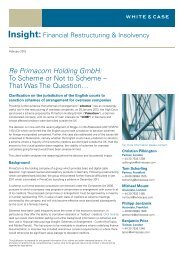Mexican Legal Framework of Business Insolvency - White & Case
Mexican Legal Framework of Business Insolvency - White & Case
Mexican Legal Framework of Business Insolvency - White & Case
Create successful ePaper yourself
Turn your PDF publications into a flip-book with our unique Google optimized e-Paper software.
46<br />
In addition to the avoidance powers the <strong>Insolvency</strong> Law affords to insolvency courts,<br />
civil laws afford the common courts the power to declare void any transaction<br />
<strong>of</strong> the debtor in prejudice <strong>of</strong> a creditor through the exercise <strong>of</strong> an Actio Pauliana<br />
[CCF 2163]. Some <strong>of</strong> the differences between the Actio Pauliana and an insolvencyrelated<br />
avoidance include:<br />
In the case <strong>of</strong> an Actio Pauliana:<br />
The rights on which the plaintiff’s claim is based must precede in time the<br />
voidable transaction [CCF 2163].<br />
The voidable transaction shall cause the debtor’s insolvency. <strong>Insolvency</strong> in this<br />
case means that the fair value <strong>of</strong> the assets <strong>of</strong> a debtor is less than the sum total<br />
<strong>of</strong> its debts (balance sheet test) [CCF 2163, 2166].<br />
The transaction would be voided only if (1) it is a gratuitous transaction; or (2) not<br />
being gratuitous, both the debtor and its counterparty acted in bad faith. Bad faith<br />
consists <strong>of</strong> the knowledge <strong>of</strong> insolvency [CCF 2164-2166].<br />
The transaction would only be void with respect to the creditor plaintiff<br />
[CCF 2175].<br />
■■<br />
■■<br />
■■<br />
■■<br />
It is not clear whether an Actio Pauliana can be exercised during the pendency <strong>of</strong><br />
a concurso.<br />
k. Musiana Presumption<br />
Marriage and concubinage are governed by civil state laws in Mexico. Most <strong>of</strong> these<br />
laws foresee two different types <strong>of</strong> patrimonial regimes applicable to marriage: (1) joint<br />
assets regime; and (2) separation <strong>of</strong> assets regime.<br />
All assets acquired under the joint assets regime in the two years prior to the beginning<br />
<strong>of</strong> the retroactive period are conclusively presumed to belong to the debtor and,<br />
therefore, are included in the estate [LCM 188].
















